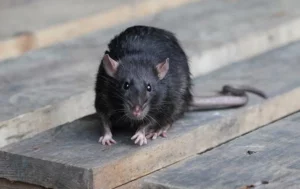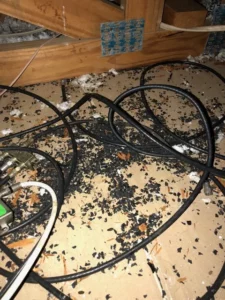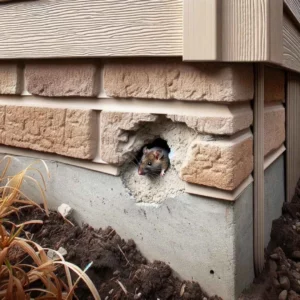
Rodents are a common pest problem in the Dallas-Fort Worth area. These small mammals can cause significant damage to both properties and pose health risks to humans. In this comprehensive guide, we will explore the different types of rodents found in the region, the dangers they pose, and how to effectively identify and deal with rodent infestations.
Before we delve into the world of rodent control, let's understand the various types of rodents commonly found in Dallas-Fort Worth. The most common types include rats and mice, but other species such as squirrels and gophers may also pose a problem.
Rats, particularly the Norway rat and the roof rat, are notorious for infesting urban areas. These rodents are highly adaptable and can thrive in various environments. They are known for their ability to squeeze through small openings, making it easy for them to gain access to buildings and homes. Norway rats are larger in size and tend to burrow, while roof rats are agile climbers and often inhabit attics and trees.

Mice, on the other hand, can be found in both rural and urban settings. They are smaller than rats and are known for their ability to reproduce rapidly. Mice are excellent climbers and can easily navigate through narrow spaces. They are attracted to food sources and can contaminate stored food items with their droppings and urine.
Squirrels are arboreal rodents that often find shelter in roofs and attics. They are known for their acrobatic abilities and can leap from tree branches to rooftops with ease. Squirrels are active during the day and are primarily herbivorous, feeding on nuts, seeds, and fruits. While they may seem harmless, squirrels can cause damage to structures by chewing on electrical wires and insulation.
Gophers, on the other hand, are burrowing rodents that can damage gardens and lawns. They create extensive tunnel systems underground and feed on plant roots, which can lead to the death of vegetation. Gophers are known for their large front teeth and powerful digging abilities. Their burrowing activities can disrupt soil structure and cause damage to irrigation systems.
Although rodents are often considered pests, they do play a crucial role in the ecosystem. As primary consumers, they help control the population of insects and other small animals. Rodents have a diverse diet, feeding on seeds, fruits, nuts, and insects. By consuming these organisms, they help maintain the balance of the ecosystem.
Furthermore, rodents serve as a food source for predators such as snakes and birds. These predators rely on rodents as a significant part of their diet, and their presence in the ecosystem is essential for the survival of these higher-level consumers. Rodents also aid in seed dispersal by caching and forgetting seeds, contributing to the growth and regeneration of plant species.
However, when their populations explode and they enter human dwellings, problems arise. Rodents can cause significant damage to structures, contaminate food supplies, and spread diseases. It is crucial to implement effective rodent control measures to prevent these issues and maintain a healthy and harmonious living environment.
One of the main concerns with rodent infestations is the potential health risks they pose to humans. Rodents can carry various diseases, including hantavirus, leptospirosis, and salmonellosis. These diseases can be transmitted through direct contact with rodents, their droppings, urine, or saliva. In some cases, respiratory problems can arise from inhaling particles from rodent nests.
For example, hantavirus is a potentially life-threatening disease that can be contracted by humans through exposure to rodent droppings, urine, or saliva. It can cause symptoms such as fever, muscle aches, and shortness of breath. In severe cases, it can lead to respiratory failure and death.
Leptospirosis, another disease carried by rodents, is caused by bacteria found in their urine. Humans can become infected through contact with contaminated water, soil, or food. Symptoms of leptospirosis include high fever, headache, muscle aches, and jaundice. If left untreated, it can lead to organ damage and even death.
Salmonellosis, commonly associated with contaminated food, can also be transmitted by rodents. These bacteria can be present in rodent droppings and can contaminate surfaces and food supplies. Symptoms of salmonellosis include diarrhea, fever, and abdominal cramps. While most people recover without treatment, severe cases may require hospitalization.
Additionally, rodents attract parasites like fleas and ticks, which can further transmit diseases to humans and pets. Fleas, for instance, can carry diseases such as bubonic plague and typhus, while ticks can transmit Lyme disease and Rocky Mountain spotted fever. Therefore, it's essential to address rodent infestations promptly to mitigate health risks.
Aside from health risks, rodents can cause extensive damage to properties and belongings. Their constant gnawing on electrical wires, insulation, and wooden structures can lead to electrical failures, fires, and structural deficiencies.

For instance, rodents have a natural instinct to chew on objects to keep their teeth from growing too long. This behavior can result in damaged electrical wires, which not only poses a fire hazard but can also cause power outages and electrical failures. In some cases, these electrical failures can lead to significant property damage or even endanger the lives of occupants.
In addition to electrical damage, rodents can also cause problems with insulation. They may use insulation materials for nesting, tearing them apart and reducing their effectiveness. This can result in poor insulation, leading to increased energy consumption and higher utility bills.
Furthermore, rodents can cause structural deficiencies in wooden structures. Their constant gnawing weakens the integrity of wooden beams, floors, and walls, potentially compromising the safety of the building. Over time, this damage can become severe and require costly repairs.
Moreover, rodents may contaminate food supplies and leave behind unsightly droppings and urine stains. Their presence in food storage areas can lead to food contamination, rendering it unsafe for consumption. This can result in financial losses for homeowners or businesses, as contaminated food must be discarded.
Additionally, the presence of rodent droppings and urine stains can be unsightly and create an unhygienic environment. These stains and odors can be challenging to remove and may require professional cleaning services to restore the affected areas.
Understanding the factors that attract rodents to your home is crucial in preventing infestations. Firstly, a readily available food source can entice these pests. Improperly stored food, uncovered trash cans, and pet food left out overnight can all attract rodents. Overgrown vegetation around the house can provide shelters and hiding spots, making it easier for rodents to establish themselves.
Additionally, gaps and openings in the building's structure can serve as entry points for rodents. It's important to inspect and seal any cracks, holes, or gaps to prevent their access.
Rodents thrive in certain environmental conditions. Moisture is particularly attractive to them. Leaky pipes, clogged gutters, and accumulated moisture in basements or crawl spaces provide rodents with the water they need to survive. Therefore, addressing any water-related issues can significantly reduce the chances of an infestation.
When inspecting for rodent activity, certain areas of your home deserve special attention. Common indoor hotspots include attics, basements, crawl spaces, and garages. Rodents prefer these areas due to their relative seclusion and warmth. Look for signs of droppings, gnaw marks, and nesting materials to determine if rodents have infiltrated your home.
Outdoors, rodents are often drawn to areas with readily available food and shelter. Keep an eye on your yard, especially around bird feeders, vegetable gardens, and compost piles. Fallen fruits and nuts can also attract rodents. Additionally, overgrown shrubbery provides hiding spots and should be trimmed regularly.
Trapping is a popular method for removing rodents from your property. Live traps allow for the capture and relocation of rodents without causing harm to the animals. However, it's important to follow local regulations and laws when dealing with wildlife. Consult with a professional pest control service to ensure proper trapping and disposal techniques.
In severe infestation cases, professional extermination may be necessary. Pest control experts have the knowledge, experience, and resources to effectively eliminate rodents from your property. They can also assist with finding and sealing entry points to prevent future infestations.
Prevention is key when it comes to rodent control. Carefully inspect the exterior of your home for any openings that rodents can use to gain entry. Seal cracks, gaps, and holes using materials like caulk or wire mesh. Pay close attention to areas around utility pipes, vents, and windows.

Furthermore, ensure that food is stored properly in sealed containers, and clean up any spills or crumbs promptly. Regularly empty trash cans and keep outdoor areas clean and free of debris that can attract rodents.
By following these tips and staying vigilant, you can successfully identify and deal with rodent infestations in the Dallas-Fort Worth area. Remember, if the problem becomes overwhelming, it's always best to seek professional help to ensure a rodent-free environment for you and your family.